Rowton House — Newington Butts
In 1892, a new type of hostel for down-and-out or low-paid working men appeared in London — the first of the Rowton Houses created by philanthropist Lord Rowton. His aim was to provide a cheap accommodation that was better and cleaner than anything else available at the time. An overview of Rowton's scheme is given on a separate page.
The first Rowton House, at Vauxhall, which opened in December 1892, was personally financed by Lord Rowton. Following its success, a limited company was formed to expand the scheme. The Newington Butts Rowton House, near the Elephant and Castle, was the third to be built — it opened on 23rd December 1897 and provided 805 beds. The location of the site is shown on the 1916 map below.
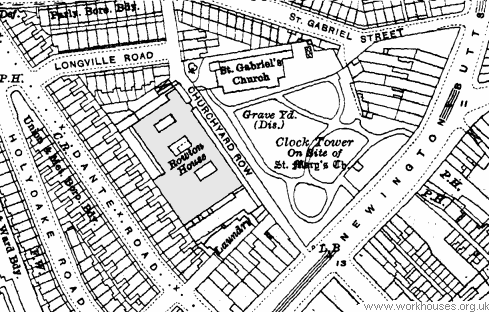
Newington Butts Rowton House site, 1916.
Rowton Houses were all constructed along the same basic lines. The ground floor and basement contained the entrance hallway, dining room, smoking lounge, reading room, washrooms, barber's shop, shoemaker's and tailor's rooms, clothes and boot cleaning rooms, parcels room etc. The upper floors contained large numbers of private cubicles each of which contained a bed, chair, shelf, and a chamber pot. Residence in the establishment cost 6d per day although no access to the cubicles was permitted during the daytime. Lodgers could either buy food in the dining-hall or cook their own food.
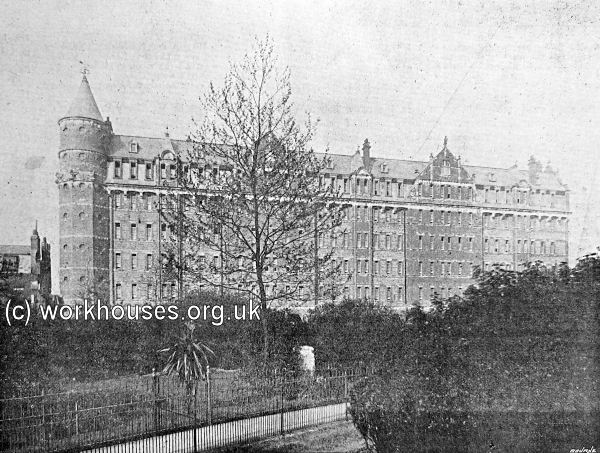
Newington Butts Rowton House, 1897.
© Peter Higginbotham.
Here is a description of the Newington Butts Rowton House from 1897:
Everything connected with the Rowton Houses is done thoroughly from the base to the roof; for instance, they have their own works department, and most of the material required is specially manufactured for the Company. In the building of this new house 1,650,000 bricks have been used, 200 tons of steel joists, 1,500 tons of Portland cement, 1,700 tons of cork breeze, while the superficial cubicle framing measures nearly an acre and a half. There are three miles of piping and two and a half acres of flooring and paving. A little more ornamentation has been introduced into the elevation of this building. The walls consist of Leicester facing bricks, relieved with mingled gaults and dressings of terra-cotta. The interior walls, consist of a dado of glazed bricks and gault bricks. Portland cement mortar has been used throughout instead of lime. The floors are constructed of concrete and steel; the staircases and landings are in Portland cement concrete so as to insure greater safety from fire. In this respect, however the advice of Sir Eyre Shaw, who is one of the shareholders in the Company has been valuable, and the danger of a fire ever spreading in a Rowton House is exceedingly small. The building consists of a basement, ground floor, six galleries of sleeping rooms or cubicles. There is a window for each cubicle, and there must be altogether a good many more than a thousand windows in the buildings. Above the first floor the building forms a rectangle; the side left open faces the sun, and here on the roof of the first floor rooms is an open-air lounge with chairs and benches. In many parts of the building there are corners for benches, and a large entrance corridor where the lodgers may lounge and smoke.
The arrangement of the rooms is similar as in the other Rowton Houses. Entering on the ground, floor, the lodger first finds himself in the dining room, a large and handsome apartment, with solid oak parquet flooring, walls with a dado of glazed tiles, and adorned with a number of beautiful engravings. There is accommodation here for 400 men, and the tables and benches are of the same comfortable type as exist in the other houses. Here, also, is the "shop," where the lodgers may buy any article of food at a small charge, and there are two large double cooking ranges at which he may cook his food. A scullery adjoins with a continuous supply of hot and cold water. Of course, the utensils are provided for the lodgers, and all cleaning and washing up done for them. The smoking and reading rooms are also on this floor. The reading room contains a large variety of engravings representing scenes from Shakespeare. The smoking room is also decorated with engravings and stags heads. Draughts, dominoes, and chess are found in the smoking-room, and newspapers and books for the use of the lodgers in the reading-room. On the basement floor are the lavatories, the baths, a barber's shop, shoemaker's, tailor's shop, laundry, &c. The sleeping galleries and cubicles are practically identical with those at the King's Cross-road house. Each cubicle is 7 feet 6 inches long and 6 feet wide. It contains a spring bedstead with hair mattress, two sheets, blankets, and quilt, a chair, a shelf, and clothes pegs. It is constructed of seasoned wood with wood flooring, nailed on concrete so as to deaden all sound. The space between the partitions and the ceiling is left free for ventilation. One of the changes made at this house is that hot water pipes for heating the rooms have not been introduced. It is found that after the house is inhabited, the heat from the dining-room and kitchen fires warms the whole building.
While every effort is made to make the Rowton House homely and comfortable to the lodgers, regulations are strictly enforced insuring the utmost cleanliness. The lodgers appreciate everything that is done for them, and Rowton Houses, without having any avowed mission, undoubtedly disseminate a very wholesome social influence.
A section of the building is set apart for administrative purposes. This consists of a residence for the superintendent, the office, and the clerk's residence, and the kitchen section, which includes sleeping accommodation for women employed in the shop, the kitchen, and scullery. A staff of bedmakers are employed during the day. They have a separate entrance and staircase, and never come in contact with the lodgers. A sitting and dining room is also provided for them.
The new Rowton House has been designed as the former were, by Mr. Harry R. Measures, who has shown great skill and ingenuity in carrying out the wishes of the company. Mr. Measures' design was so perfect, that in no single particular during construction has any requirement been made either by the County Council or the local authority. Lord Rowton pays great personal attention not only to the institutions at work, but to the new buildings in course of erection. His right-hand man has always been Sir Richard Farrant, who has more experience in the management of working men's dwellings than anyone else.
The dining room tables had a total floor area of 6,300 square feet and seated 440 men, with a number of extra seats and wooden easy chairs provided. The walls were built with a high dado of cream and chocolate tinted glazed brickwork, with plastering above tinted to a shade of terra-cotta. Pictures were hung in frames around the room. The tables and seats were made of teak on cast iron standards. Four large cooking-ranges, with ovens, hot plates, and grills were provided out of the line of traffic in each part of the rooms; large boilers at the back of two of these provide a supply of boiling water for lodgers for making tea etc. Tea or coffee cost a halfpenny for a small and a penny for a large cup. A slice of bread cost a half-penny. Eggs cost a penny each, bloaters the same, kippers the same. A haddock cost twopence. Butter or jam costs a half-penny. Salmon cost a penny and two-pence, according to the bill of fare. Puddings cost a penny, hot joints fourpence, cold joints threepence, and bacon twopence. There was no caviare on the bill of fare, but it was to be had for money.
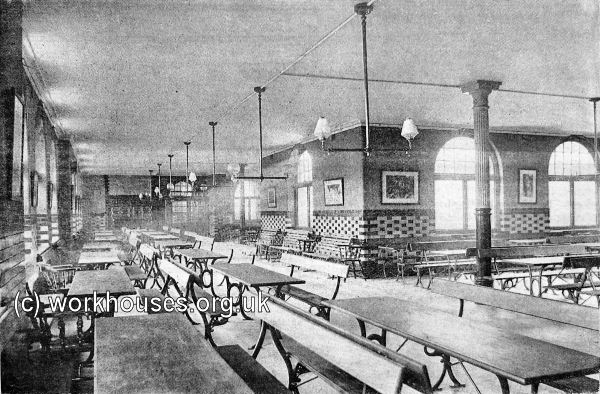
Newington Butts Rowton House dining hall, 1897.
© Peter Higginbotham.
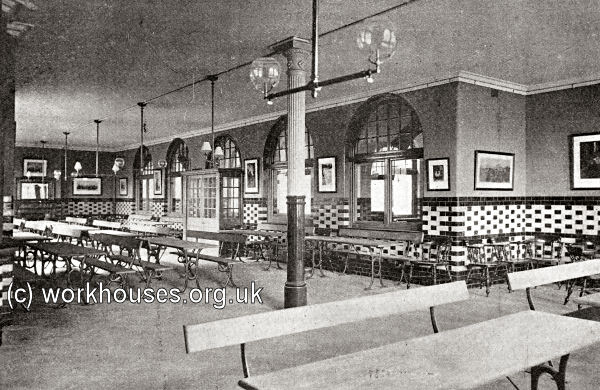
Newington Butts Rowton House smoking roo, 1897.
© Peter Higginbotham.
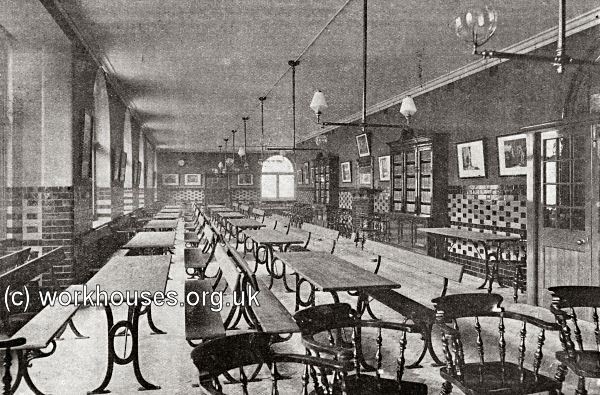
Newington Butts Rowton House reading room, 1897.
© Peter Higginbotham.
The lavatory and feet-washing room was 30 feet wide by 71 feet long, and had a French grey and ivory dado, with ivory walls and moulded cornices above — all in glazed brickwork. There were 80 lavatory basins, white enamelled fireclay, fitted up with polished slate top, brass taps for hot and cold water supply to each basin, towel and hat rails. The waste pipes from each lavatory were discharged over an open white enamelled earthenware chancel in the floor, and the flooring was laid with falls to this channel throughout for cleansing and speedy drying.
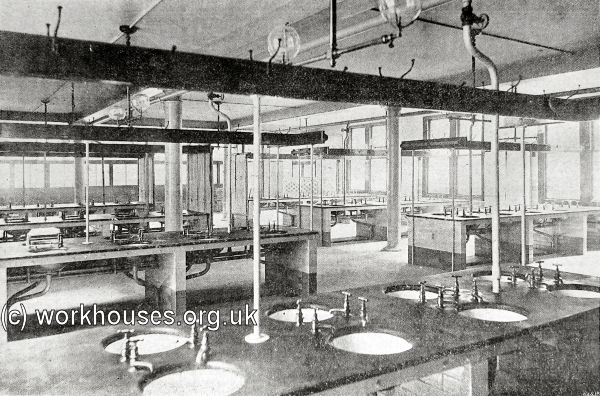
Newington Butts Rowton House lavatories, 1897.
© Peter Higginbotham.
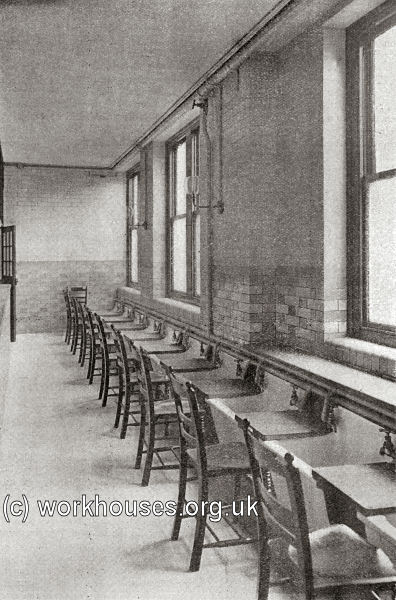
Newington Butts Rowton House fet-washing room, 1897.
© Peter Higginbotham.
The house had its own barber's shop. The barber was himself a lodger. The price of a shave was a halfpenny. Hair cutting was more expensive. The shoemaker was also a lodger and his prices were of a most moderate character. Every lodger had a locker. Large items could be deposited, without cost, in the parcels room. There was a room for blacking boots, and a lodgers' wash-room. Here, a man with only one shirt could wash and dry it and so always have a clean shirt.
At the foot of the staircase leading to the cubicles was a placard saying:
Please go to Bed Quietly.
No Smoking allowed in the Bedrooms.
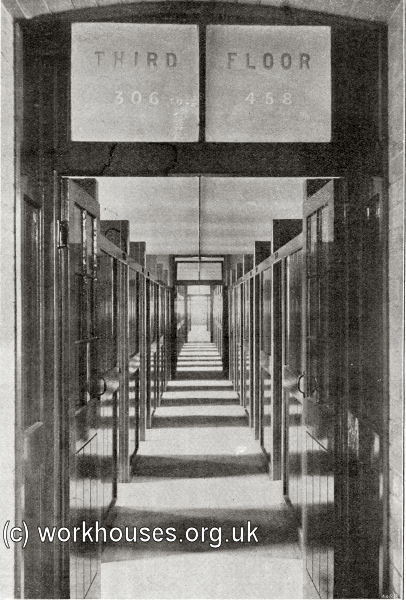
Newington Butts cubicle corridor, 1897.
© Peter Higginbotham.
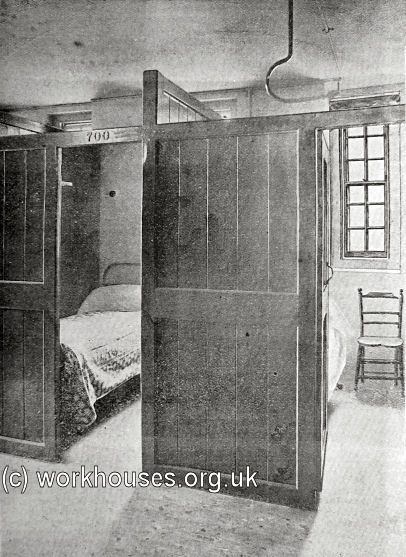
Newington Butts sleeping cubicles, 1897.
© Peter Higginbotham.
On 28th February 1903, a new wing was opened increasing the house's capacity to 1017 beds.
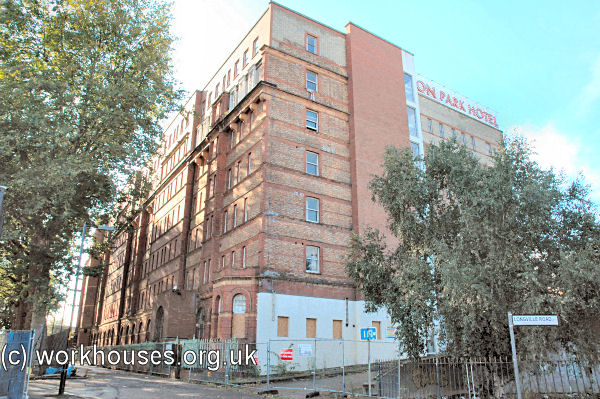
Newington Butts Rowton House, 2006.
© Peter Higginbotham.
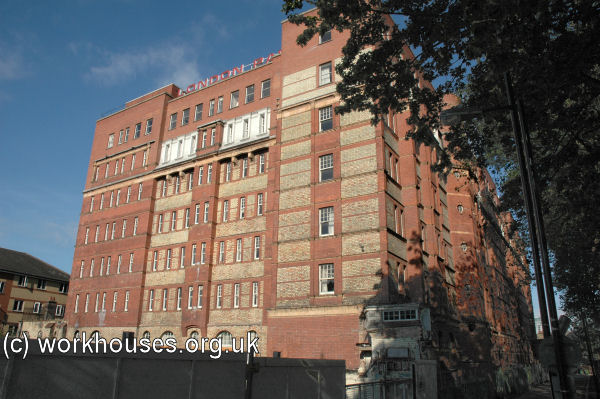
Newington Butts Rowton House, 2006.
© Peter Higginbotham.
The Newington Butts Rowton House, later renamed Parkview House, was re-opened as the London Park Hotel on 1st May, 1972. After its closure in the early 1990s, the building was used to house refugees and asylum seekers. The building was demolished in December 2007. Immediatley prior to that, had been used for location filming on the BBC TV series Hustle.
Other Rowton Houses
The other Rowton Houses in London were:
- Vauxhall — opened 31st December 1892
- King's Cross — opened 1st February 1896
- Hammersmith — opened 2nd December 1899
- Whitechapel — opened 11th August 1902
- Camden Town — opened 7th December 1905
A number of Rowton-style hostels were also opened outside London, such as the Birmingham Rowton House in 1903.
Bibliography
- Cornes, James (1905) Modern Housing in Town & Country (London: Batsford)
- Farrant, Richard (1904) Lord Rowton and Rowton Houses in Cornhill Magazine, June 1904.
- Sheridan, Michael (1956) Rowton Houses 1892-1954 (London: Rowton Houses Ltd)
Links
- None.
Unless otherwise indicated, this page () is copyright Peter Higginbotham. Contents may not be reproduced without permission.


